Introduction
Today, the period in Europe from about the year 500 through approximately 1500 CE is called the Middle Ages, or the medieval era (the word medieval comes from the Latin medium aevum, literally middle age). But of course people who lived at that time did not think of themselves as being in the middle of anything—they, like we, referred to their own time as “modern.” A seventeenth-century German historian, Christoph Keller, first came up with the idea of dividing history into ancient, medieval, and “new period.”
The cultural phenomenon called the Renaissance began in Italy during the fourteenth century and spread throughout much of Europe by the end of the sixteenth century. It involved a flowering of art and scholarly and philosophical pursuits, often inspired by a renewed interest in the Classical cultures of ancient Greece and Rome. Some historians of the nineteenth century saw the Renaissance as a sharp break with the medieval “dark ages,” a sudden burst of intellectual light after the supposed gloom and stagnation of the Middle Ages.
However, that view has been eclipsed by more recent historians who emphasize the accomplishments of the medieval period. In fact, the European Middle Ages were a time of tremendous creativity and innovation. The era saw the development of many institutions we take for granted in the world today, in law, government, and education. Medieval artists and craftspeople created exquisite works, from tiny, detailed miniature illuminations adorned with gold leaf, to radiant fresco paintings, to soaring cathedrals glowing with intricate stained glass pictures. Medieval thinkers grappled with the writings of the ancient Classical philosophers, incorporating Aristotelian logic into new methods of working through theological debates. Medieval inventions include staples we take for granted in our everyday lives, from buttons, mechanical clocks, and eyeglasses to systems of banking, credit, bookkeeping, and insurance.
The Renaissance certainly encompasses a distinctive culture, with indisputably new ideas. But many areas of life experienced more continuity with the Middle Ages than change. Medieval Europe bequeathed a legacy to the Renaissance and beyond that continues to influence our thought, art, institutions, and culture. Writings and book illustrations from the Middle Ages demonstrate the vitality of the period.
Essential Questions
- Why might Renaissance and later historians want to envision an abrupt difference between their own times and the medieval past?
- How do medieval manuscripts help us to understand the “long view” of the development of many modern institutions?
The Development of Law and Government
The foundations of modern nation-states and legal codes were established during the Middle Ages. From about the eleventh century (centuries before the Renaissance), judicial courts in continental Europe drew upon the law codes of ancient Rome as models for the development of complex legal systems. Roman law, which came to be called civil law (from civis, the Latin word for city) seemed especially well suited to regulating the vibrant commercial trade and property transactions that flourished during the central Middle Ages. This body of law was reworked and codified as the Napoleonic Code in the early nineteenth century, and it remains the basis of the legal codes of many European countries today.
England’s legal history took a different course, with the evolution of “common law,” or case law. In a common law system, precedent—previous decisions by courts on various matters—is as important as official law statutes. Courts in a civil law system have no authority other than what is provided for by specific laws. In common law courts, judicial decisions themselves become “law,” with the same authority as statutes. The English common law system came to North America with British colonists, and it forms the basis of the judicial system of the United States. Thus our courts have the independent ability to interpret law texts and set precedents that become the basis of future court decisions.
The basis of modern representative governments also progressed in medieval England. Early in the Middle Ages, Anglo-Saxon kings convened assemblies of noblemen (often called barons in England) and high officers of the church, in an institution called the Witenaġemot or Witan. Members of the Witan provided the king with advice and counsel and also had the right to consent to new laws and any changes to ancient custom. Anglo-Saxon England also established a sophisticated system of regional and local administrative units and judicial tribunals. The kings issued writs, formal written orders documenting royal actions, appointments, and decrees.
The French-speaking Normans, who conquered England in 1066, retained this basic governmental framework, while replacing most Anglo-Saxon officials with Norman lords and churchmen. They also changed the language of official documents from Old English to Latin. At the time, Latin served as a common language across Europe for governmental and church matters. Norman kings also established the much-hated Forest Law, which set aside vast tracts of forest land in England for the exclusive use of the king. No one else was permitted to cut wood or hunt game in royal forests; penalties for violations of the Forest Law could include mutilation or even death.
By the thirteenth century, the Angevin dynasty of Norman kings had eroded the role of noblemen in English government. Advancing a principle they called “force and will,” they claimed the right to make arbitrary decisions, theorizing that the king, as the established representative of God on earth, was above or outside the law. This contravened the time-honored recognition in England of the authority of custom and laws. Resistance to this change generated open rebellion by many barons against the unpopular King John. The rebels swore to “stand fast for the liberty of the church and the realm.” In 1215, the Archbishop of Canterbury, England’s highest church official, supervised peace talks with the rebels and helped them to draft a set of demands. These were formalized into a document known as the Great Charter, or Magna Carta. In June of that year, the rebels and King John met in a meadow called Runnymeade, about twenty miles outside London. John agreed to set his seal to Magna Carta, signifying his agreement to its principles, and the barons renewed their oaths of loyalty to the king. Shortly thereafter, the Pope declared the Charter invalid, saying John had accepted it under duress, and John repudiated it. Civil war broke out in England, ended abruptly by the king’s death from a sudden illness in October 2015. He was succeeded by his nine-year-old son, who became King Henry III.
Although today we consider Magna Carta a foundational document of later representative governments in the United Kingdom and many of its former colonies, including the United States, it by no means featured a democratic outlook. It constituted a list of sixty-three rights demanded by the highest noblemen of the land, with no intention of extending those rights to the great majority of the population who farmed the land or worked as laborers in the growing towns and cities. However, it did decisively establish the principle that a king, like everyone else, is subject to the law. Especially important clauses to later developments include these:
“No free man shall be seized or imprisoned, or stripped of his rights or possessions, or outlawed or exiled, or deprived of his standing in any other way, nor will we proceed with force against him, or send others to do so, except by the lawful judgement of his equals or by the law of the land.”
“To no one will we sell, to no one deny or delay right or justice.”
The Great Charter was amended, rewritten, and reissued several times over the next century, most importantly in 1225 by Henry III. In 1217 Henry also sealed the Charter of the Forest, which reduced the amount of land considered royal forests, and gave some rights of common access to royal private lands. Such access was crucial to common people as well as nobles, as they relied on wood and turf for fuel and also needed to pasture animals like pigs and sheep on those lands. This charter also repealed the death penalty for hunting game on the king’s lands, though violators could still be fined or sent to jail. In 1297 King Edward I confirmed Magna Carta and the Charter of the Forest, having them copied into the official Statute Roll as official laws. Many handwritten copies were made of the 1297 version.
Parallel with these legal developments, England’s political system also evolved to place limits on the authority of the king. By the thirteenth century, the advisory body called Parliament, made up of barons and high church officials, had gained the rights to be consulted by the king and to consent to new laws and taxes. In some cases, lesser-status knights and urban people, called burgesses, were also called to contribute their opinion. This group of people outside the ranks of the nobility became known as the Commons. King Edward I, who reigned from 1272 to 1307, started the practice of allowing all Englishmen, including commoners, to petition Parliament about their grievances directly. The amount of authority Parliament enjoyed waxed and waned over the next few centuries, as some strong kings were able to impose their will without worrying about Parliament’s consent. After the Middle Ages ended, some English kings tried to assert absolute authority based on divine right. The ultimate supremacy of Parliament over the king was not settled until the late seventeenth century, after a civil war, the beheading of one king, and the deposition of another in what is known as the Glorious Revolution.
Question to consider:
- Who was left out of the provisions of Magna Carta?
Magna Carta, Carta de Foresta, and other 13th-century statutes, England, c. 1300?
The Newberry’s copy of the Magna Carta and the Forest Charter was probably made around the year 1300. It is bound in a tiny book along with a number of other statutes of the time. It also contains curious additions, such as a threatened curse by the bishops of England on anyone who violates any charters (medieval legal documents). The two main documents and most of the laws are in Latin, but a few statutes are written in French, which the king and nobles would still have spoken at this time, a remnant of their Norman heritage.
Modus Tenendi Parliamentum; Tractatus de Senescalcia Anglie, England, mid-15th century
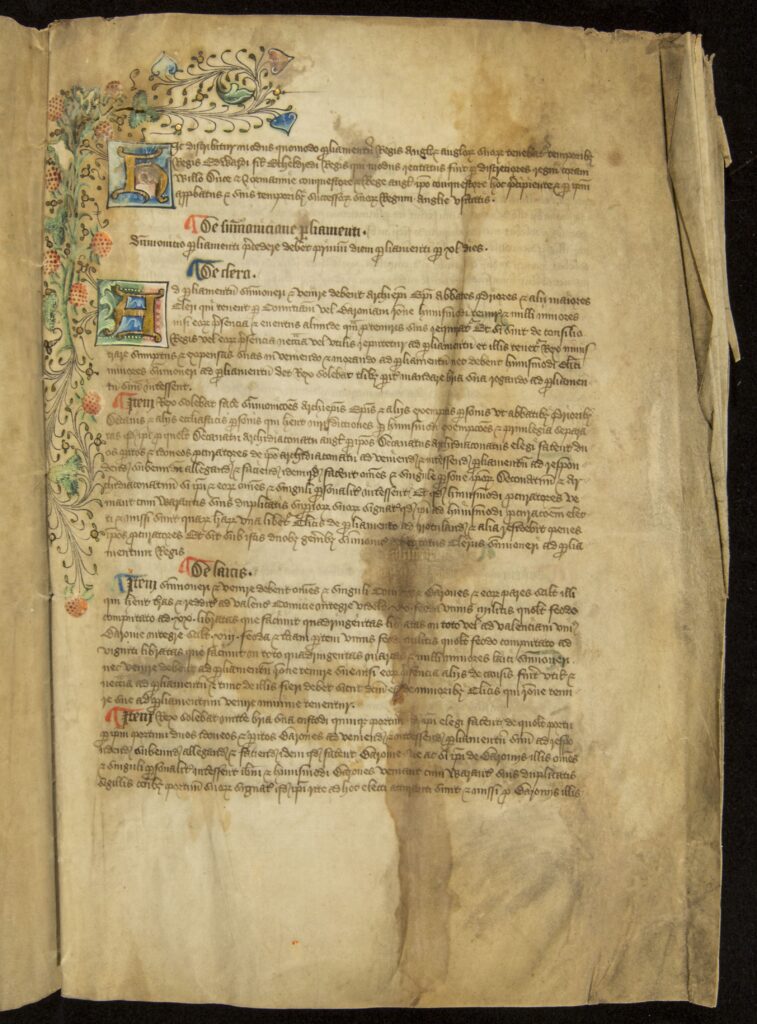
The Modus Tenendi, originally written during the fourteenth century, provides a summary of the procedure of Parliament. Its description of parliamentary procedures and organization are now believed to be idealized, rather than descriptive of actual practices. The Newberry’s copy, which includes initials in burnished gold leaf and a lovely border of strawberries and flowers, is one of nineteen known copies that date to the Middle Ages.
Universities and Book Production
At today’s high school and university graduation ceremonies, participants wear long robes, often in bright colors. Faculty members and those graduating from master’s or doctoral programs may also wear “hoods,” a length of multi-colored cloth draped around the neck and hanging down the back in elaborate folds. Both garments serve as reminders of the medieval origins of the university.
Universities grew out of an older medieval tradition of cathedral and monastic schools. By the eleventh century, such schools in cities throughout Europe were attracting large numbers of young men eager to learn. The Latin word universitas means a community or corporate body. The first university, a legal corporation of students and masters that set the curriculum, standards, and degrees, was established in the Italian city of Bologna in 1088. Universities spread rapidly throughout Europe, with more than sixty established before 1500. Students and faculty were considered minor church functionaries, so they wore the same kinds of robes as priests and monks, with at that time attached hoods that could be pulled up over the head.
The basic course of university study centered around the seven liberal arts, a curriculum passed down from late antiquity. These included the trivium of Latin grammar, logic, and rhetoric (or persuasive argument), and the quadrivium of arithmetic, geometry, music (theory, not performance), and astronomy. Some students continued on to higher courses of study in medicine, law, philosophy, or theology. All classes were conducted in Latin—students from all over Europe could attend a university in any city and converse in that language with students and masters from various origins. From very early on, universities excluded women and non-Christians. Soon university training became a prerequisite for many high government and church positions, and also for professions such as medicine and law.
The rise in universities stimulated a huge new demand for books. Before the medieval invention of moveable-type printing in the West, in the mid-fifteenth century, every word in every book had to be laboriously handwritten. While production of high-end luxury manuscripts, decorated with miniature illuminations and gold leaf, flourished (see the Religion and Popular Piety section below), books needed by hundreds of university students were usually produced as inexpensively as possible and often quite plain. Those that survive show evidence of heavy use, often including marginalia (notes written by readers in the margins and between lines of texts) and manicules (little drawings of a hand, with a finger pointing to a line the reader wants to emphasize—similar to today’s students using a yellow highlighter).
In the second half of the fifteenth century, the advent of printing technology revolutionized book production, permitting much faster manufacture of copies. Medieval books printed before the year 1501—when print was in its infancy—are called incunabula, from the Latin word for cradle. In the earliest incunables, printers tried to make their books look as much like traditional handwritten ones as possible. They used the same format as manuscript books, and imitated handwritten scripts with their typefaces. But soon printers experimented with new techniques and apparatuses, creating a look distinctive to printed books.
Questions to consider:
- How might a proliferation of literacy and book production change earlier medieval social structures?
- How would the necessity of university training to enter many professions change opportunities available to those who were not permitted to attend?
Principia in sacrum, and other works, Southern France, c. 1325
This book includes a collection of texts assembled from different independent manuscripts and bound together for the use of a university student. It includes many treatises and sermons routinely assigned for the study of theology. It also contains a very rare example of a work by Pierre Jean Olivi, a Franciscan professor at the University of Montpellier in France. Some of Olivi’s theological writings were controversial, though he defended them successfully to a council. But after his death most of his writings, including this one, were declared heretical and burned, so very few survive. Notice the owner’s marginal notations and the manicule (the little hand drawn at the upper right of the page).
De vita et moribus philosophorum (On the lives and deaths of the philosophers), printed in Cologne, 1473 or earlier
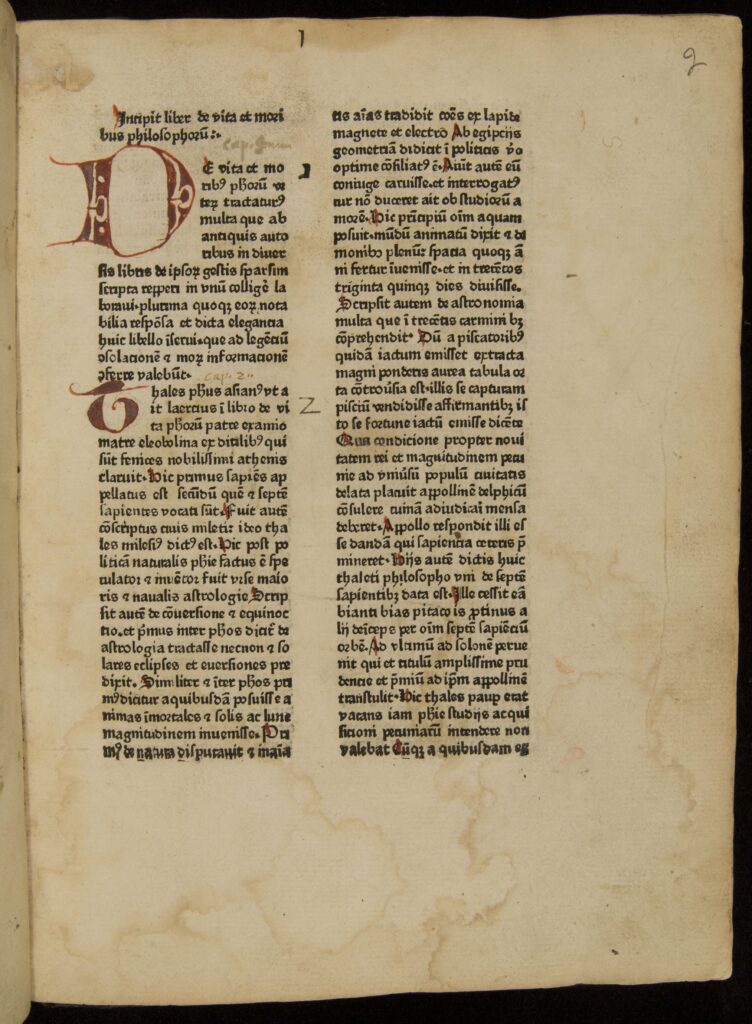
This early incunable of a text for students of philosophy was typeset and laid out to look as much as possible like a medieval manuscript. An incunable is a text printed in the earliest stages of printing in Europe, before the printing press became widespread. This is the first page of the book—like most manuscript books, it does not open with a separate title page. The printer also left empty spaces at the beginning of new sections of the book; an artist later added the large colored initial letters you see here, in imitation of the medieval practice called rubrication (from the Latin word for a red ocher color, though in practice initials in medieval books could be worked in many colors).
Discordiantiae sanctorum doctorum Hieronymi et Augustini, Printed in Rome, 1482
This incunable, a theology text, demonstrates great strides in printing design in just a few years, compared with the previous book. The first page features an elaborate woodcut border and initial, and woodcut initials and illustrations appear, as seen in the second image here. In addition, titles in bold type and blank spaces indicate breaks and sections within the book, instead of expecting a hand-rubricator to mark those.
Early printed books often remained in use for many years. When this book was rebound around the year 1500, the new owner had a portrait of himself painted on the front cover, and his coat of arms on the back. He has been identified as Matteo Corti, who later became personal physician to Pope Clement VII.
Religion and Popular Piety
In the early Middle Ages, most European people’s active religious practices were limited to attending church on Sundays and occasionally participating in sacraments like baptism, communion, and confession. Common people and nobles supported communities of monks or nuns who withdrew from the world and spent much of their days in ritual prayer for the benefit of the larger society. Ordinary people relied on the prayers of these religious to intercede with God on their behalf. Church services were conducted in Latin, which few could understand. Literacy was low, and the rare manuscripts of the Bible that existed were almost exclusively in Latin also, so scarce opportunities existed for lay people (people who were not priests, monks, or nuns) to experience religion in a meaningful way.
From about the thirteenth century on, due partly to the spread of universities, a larger proportion of the elite classes could read Latin (if not write it—writing was taught as a separate skill, often limited to professional scribes and religious officials). About the same time, many people began to yearn for a closer, more personal relationship with God and the saints. This led to a movement called popular piety, in which lay people, first primarily from the upper classes but then joined by an emergent well-off urban merchant class, developed practices to incorporate religious observance into their everyday lives out in the world. This movement included new devotional practices, pilgrimages to holy sites, and group activities like processions. Many scholars have noted a new religious individualism in this movement, an ideal of connection between the individual and God not mediated by priests. This medieval personal piety movement prefigured both the Renaissance ideal of individualism and later Protestant pietism.
A compilation of saints’ day calendars, biblical readings, prayers, hymns, and other devotional material known as a Book of Hours was first created about 1240 in England, and the books became wildly popular by the fifteenth century. The contents are based on the Divine Office, the lengthy recitations of Psalms, other Bible readings, and other liturgical material performed by monks and nuns at eight specific hours, or time periods, each day. But in a Book of Hours these devotions are abbreviated, so that a lay person could spend a few minutes on them several times a day, rekindling their relationship with God and the saints. Mass production of expensive, luxurious, and lavishly illustrated Books of Hours handwritten on fine parchment arose in several cities, with the best-known center in Bruges, in modern-day Belgium. Less expensive versions with fewer illustrations followed for the merchant classes.
Book of Hours, Use of Salisbury, Bruges, c. 1455
This gorgeous example of a luxury Book of Hours was created in Bruges for the English market. Featuring brilliant colors, generous use of gold leaf, and typical millefleur (thousand-flower) borders, it was scrupulously cared for and used by a succession of owners. The first image shows a miniature illumination of Saint Thomas Becket in Canterbury Cathedral, about to be assassinated by soldier of the English King Henry II. In 1538, King Henry VIII, who by that time had broken with the Catholic pope and declared himself head of the church in England, issued a decree “unsainting” Thomas. He ordered all references to Thomas to be stricken from religious books. You can see on the page facing the illumination that the owners of this book during Henry’s reign have complied by lightly crossing out the prayer to Saint Thomas. Apparently they could not bring themselves to deface the beautiful illustration.
Further demonstrating the way that medieval religious books continued to be valued and utilized long past the Middle Ages, even in Protestant households, the endpapers of this book were used to record marriage and birth records for two sixteenth-century English noble families. The inscription in the second image here begins “The namys of the children of Wilham Gonstone and Benet his wif of the perisshe of Saincte Donistones in the est as hereafter ffolowith.” Subsequent entries record such events as the birth of the couple’s first son, Dany, on November 29, 1508, at five o’clock in the morning.
On the following page appears records of the family of “Sir Thomas Myldmaye, knight, and the Ladye Frauncys his wiefe,” recording the births of their five daughters and three sons, plus a son borne to Thomas by his second wife Margaret, over the years from 1568 through 1593. This Thomas Mildmay was the nephew of Sir Walter Mildmay, Chancellor of the Exchequer to Queen Elizabeth I.
Questions to consider
- Why might church authorities be uncomfortable with lay people’s turn to a more personal religion?
- What opportunities might the personal piety movement have provided for women in medieval society?
Book of Hours, Use of Rome, Bruges?, c. 1450
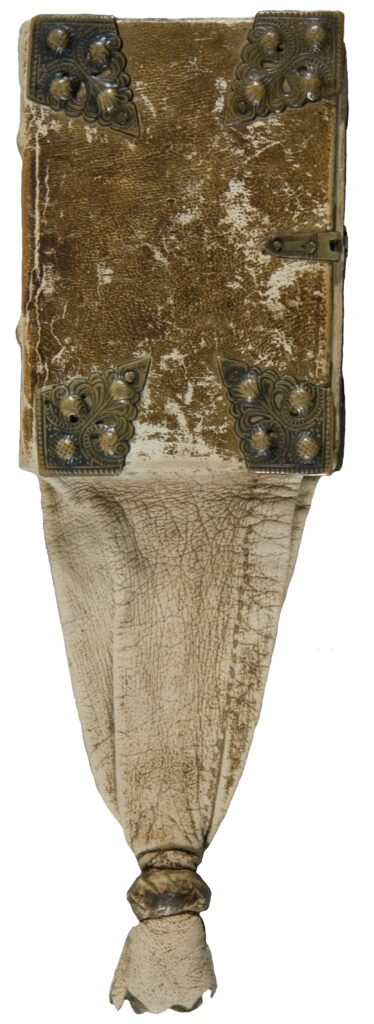
This small Book of Hours is significant for its “girdle binding” (in this context “girdle” means “belt”). The portable book could be hung from the belt and carried around. That allowed people to pause in their normal tasks at the allotted time, pick up the book and complete the appropriate readings and prayers for the time of day, then drop the book and continue with what they was doing. We know girdle books were popular, based on hundreds of images of people wearing them, but very few of them survive. The Newberry’s is one of fewer than thirty known medieval examples.
Medieval Illumination: Women Wearing Girdle Books, date unknown

During the eighteenth and nineteenth centuries, cutting illustrations from medieval books and pasting them into scrapbooks became a popular pastime. This illustrated initial cut from an unknown manuscript shows two women wearing girdle books like the one above.
Humanism before the Renaissance
The Renaissance humanist project included the revival and study of the classics of ancient Greece and Rome. But ancient philosophers like Aristotle were respected and relied upon as authorities throughout the Middle Ages. In the twelfth century, additional works by ancient Greek authors like Aristotle became available in Western Europe for the first time in several centuries, brought east by Crusaders or north from Muslim Spain. European scholars reading about ancient Greek systems of thought devised a method of learning and debate that came to be called Scholasticism after its development by “scholastics,” or school-men, of the universities.
Scholasticism’s aim was to use dialectical reasoning, or formal logic, to draw conclusions and resolve contradictions. It evolved into a rigorous system of disputation, involving logical rebuttal of proposals and counterproposals. The scholastic method was applied to many fields of study, but its main aim was to harmonize and reconcile Christian teachings with Classical philosophy, especially with the works of Aristotle and the Neoplatonists. Some Italian Renaissance humanists dismissed scholasticism and its focus on theology. But Renaissance humanists in Northern Europe remained more interested in Christian texts and less hostile to scholastic method.
Question to consider:
- How did the medieval scholastic method influence Renaissance humanism?
Politica and Rhetorica, Bologna?, 13th century?
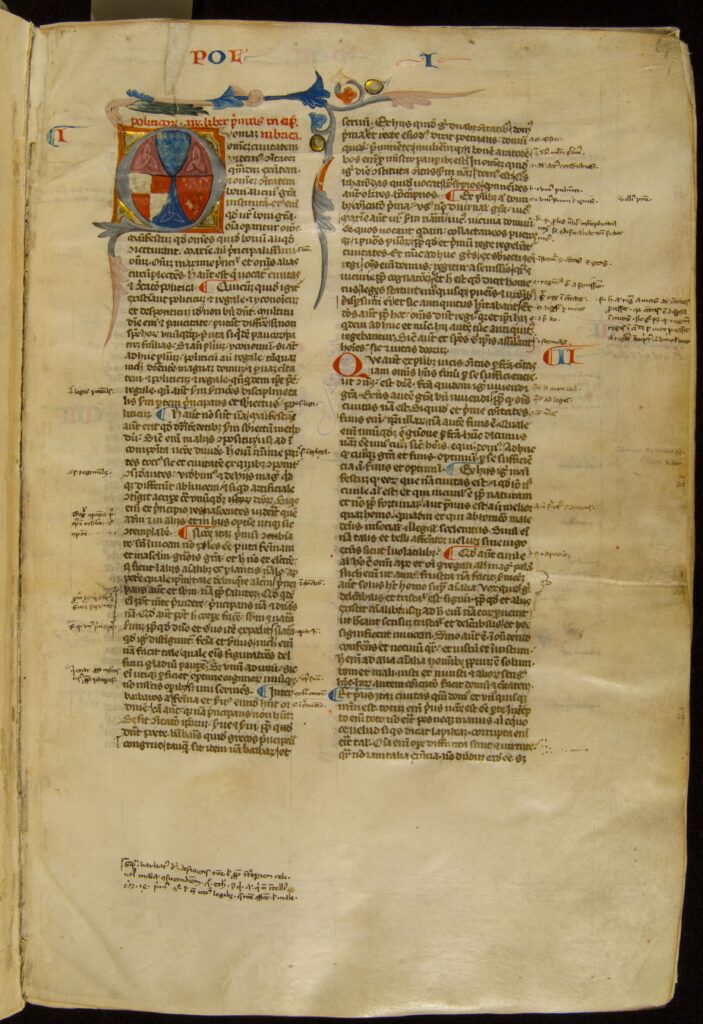
This Latin version of two of Aristotle’s most important works may date from as early as the year 1200. It is written in a script called gothic bookhand, with colored initials and headings.
Physica, De Caelo et Mundo, Metaphysica, Parva Naturalis, and other works, Germany?, early 14th century
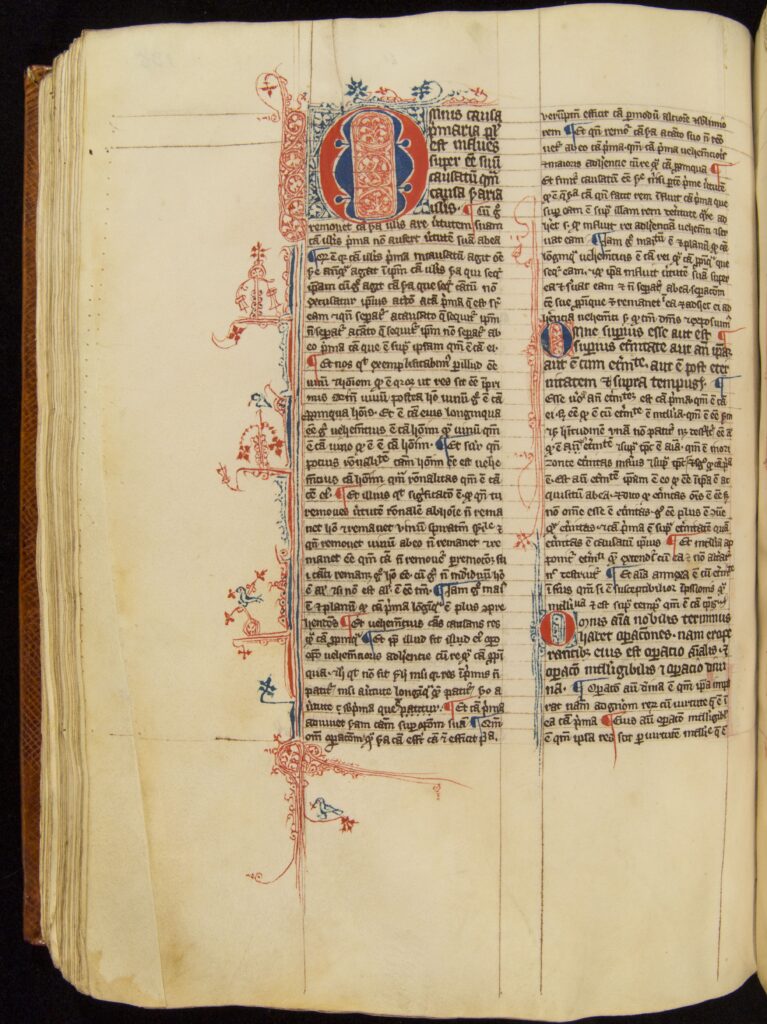
This Northern European compendium contains Latin translations of many works by Aristotle, as well as material by other philosophers and theologians. Written in a later gothic script, it includes large red or blue initials marking new sections of the text. Many initials on this page sport elaborate “pen flourishes” that extend to create a border.
De Ethica ad Nicomachum, translation of Johannes Agryropolus, Florence?, late 15th century
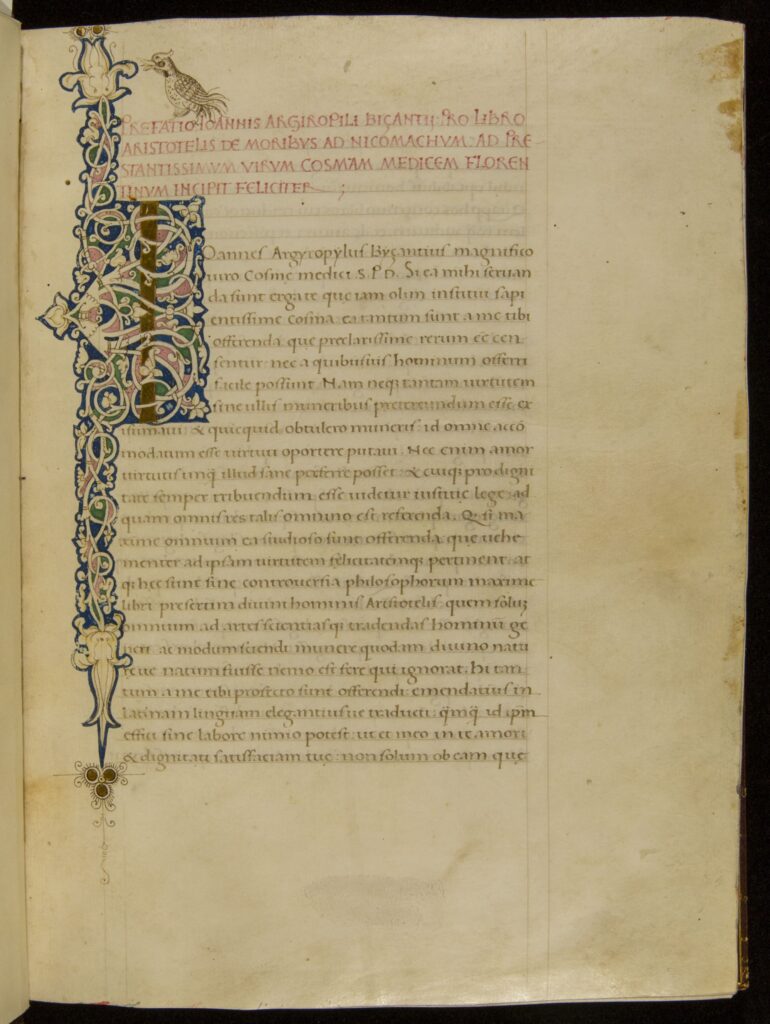
This was a new Latin translation of one of Aristotle’s works by the famed fifteenth-century Greek-born humanist John Agryropolus. Its beautiful clear script, developed in Italy around 1400, is called “humanist minuscule.” This page also features a gold-leaf initial with green, blue, and pink vine-stem decoration, with a drawing of a bird at the top.
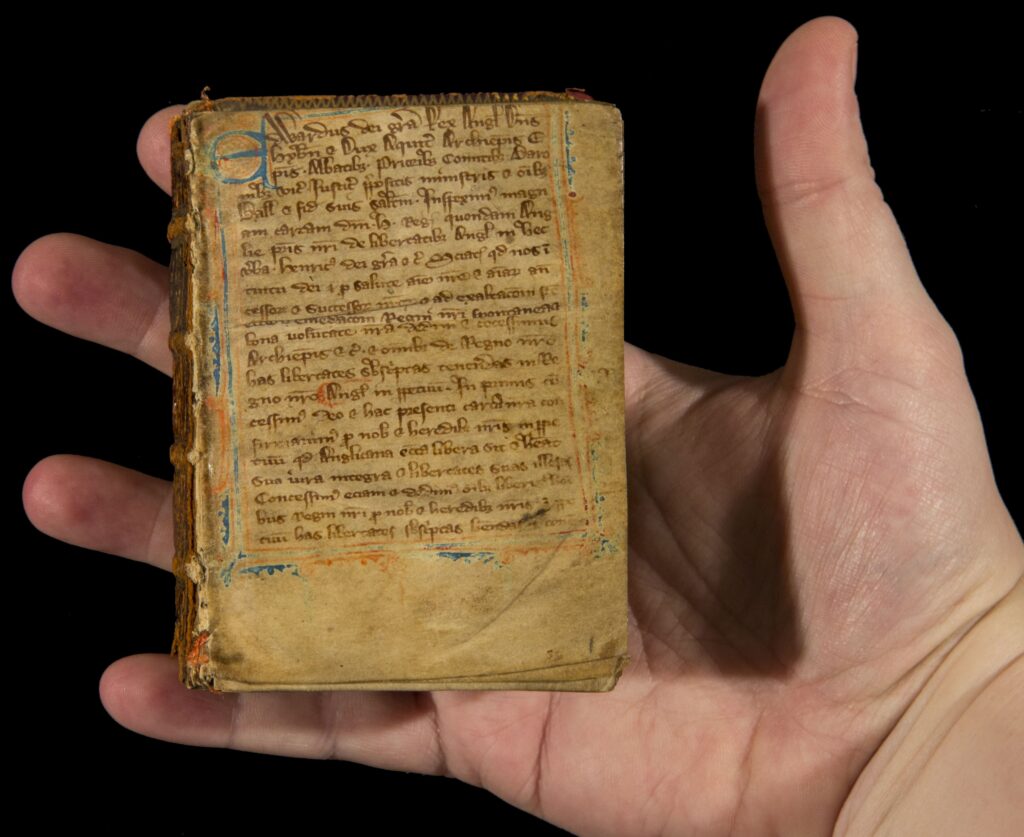
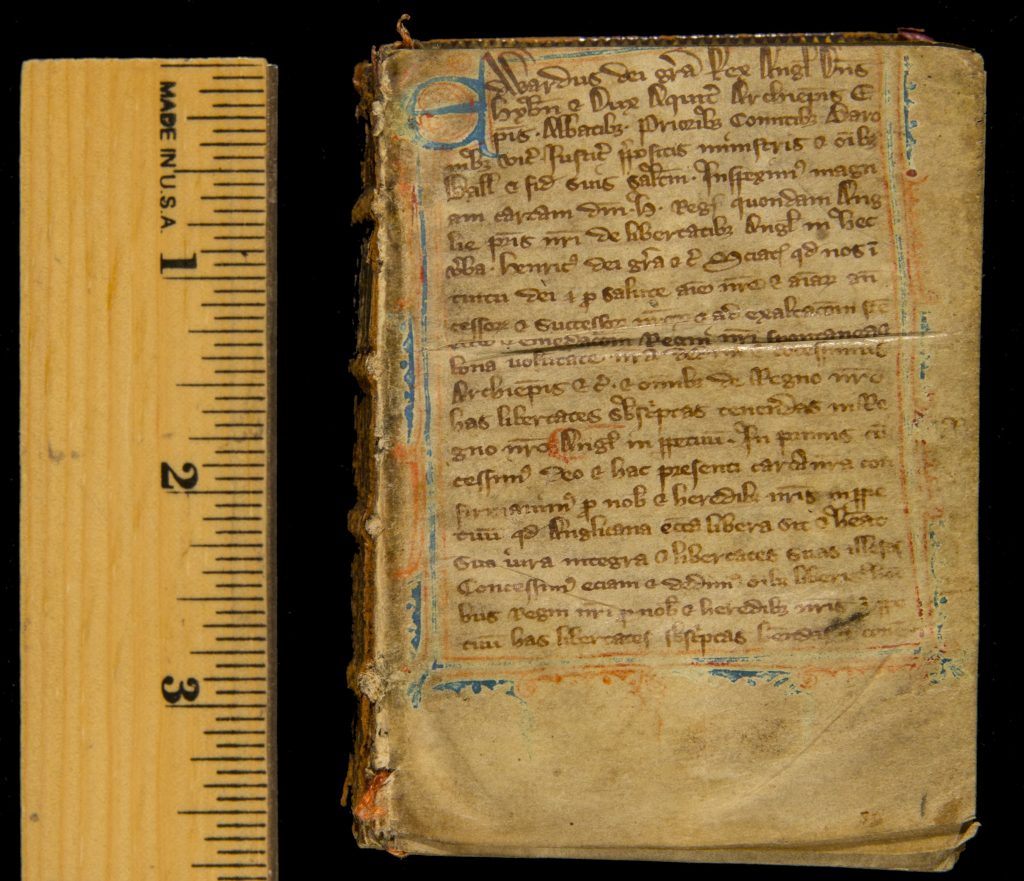

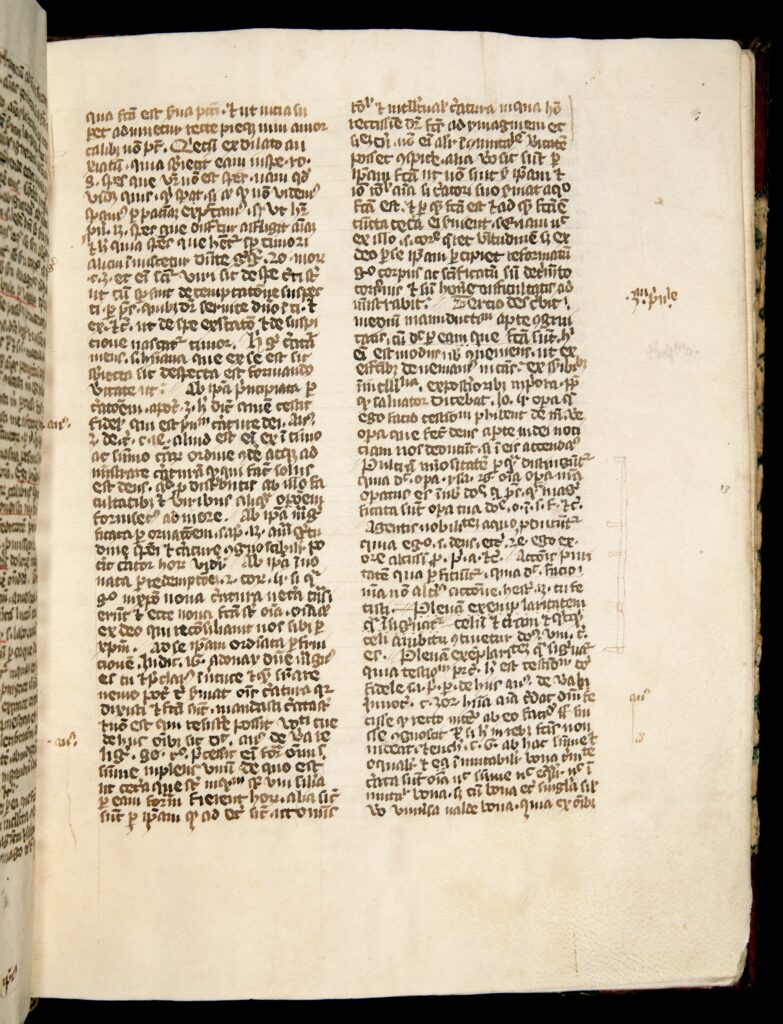
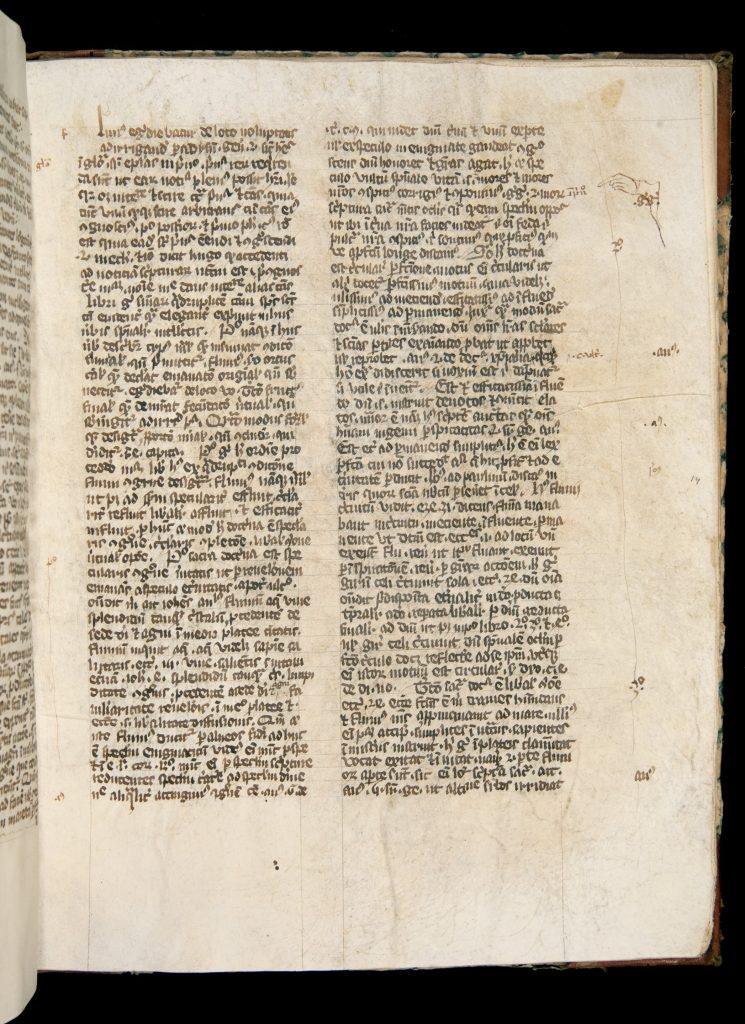
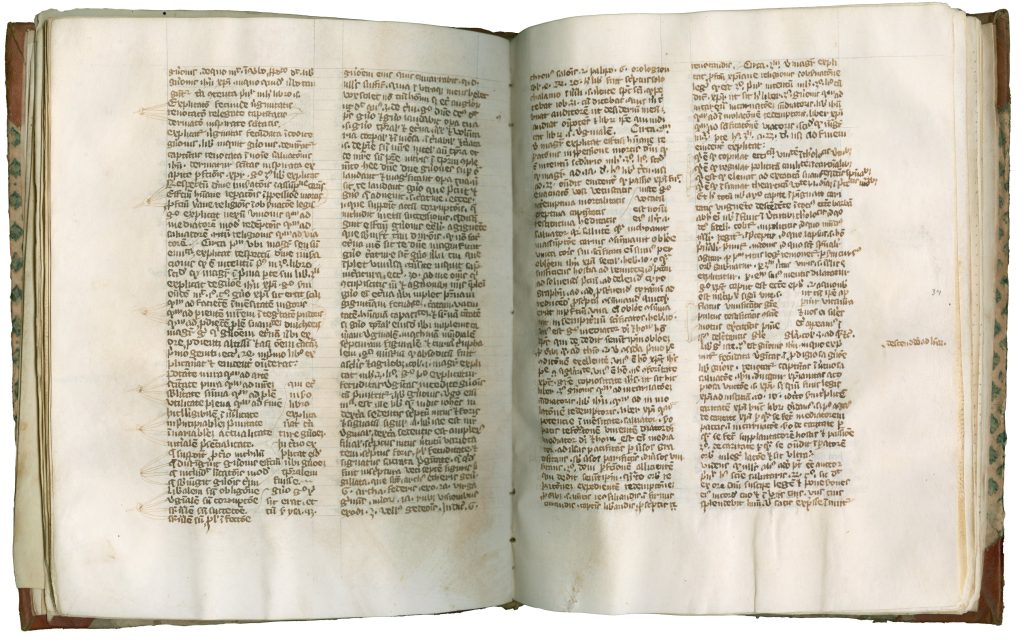

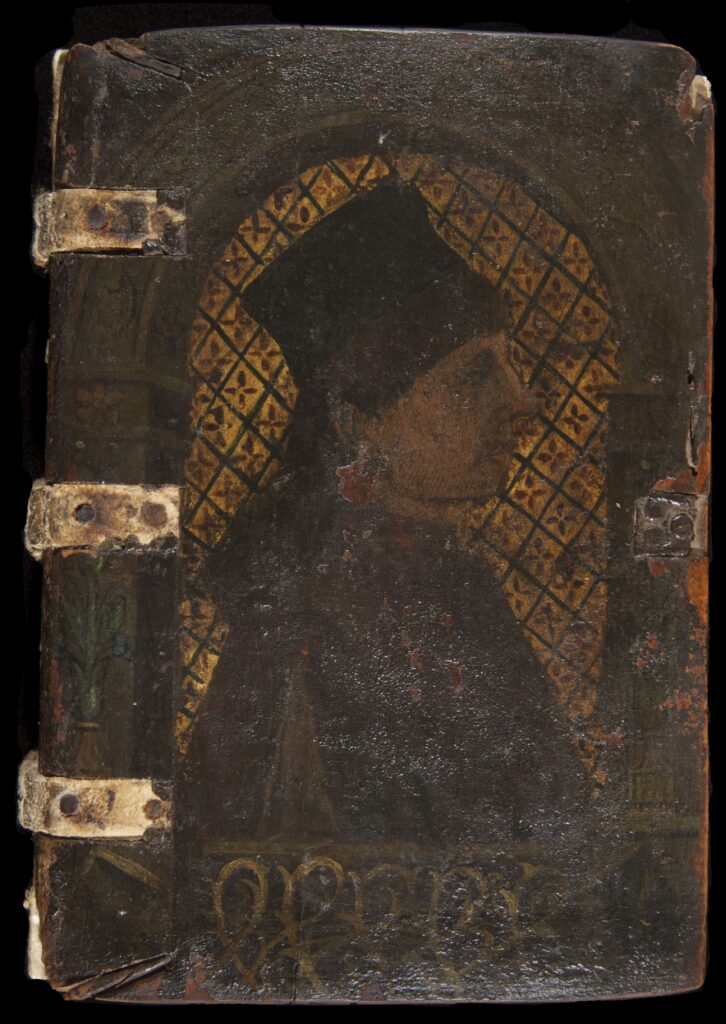
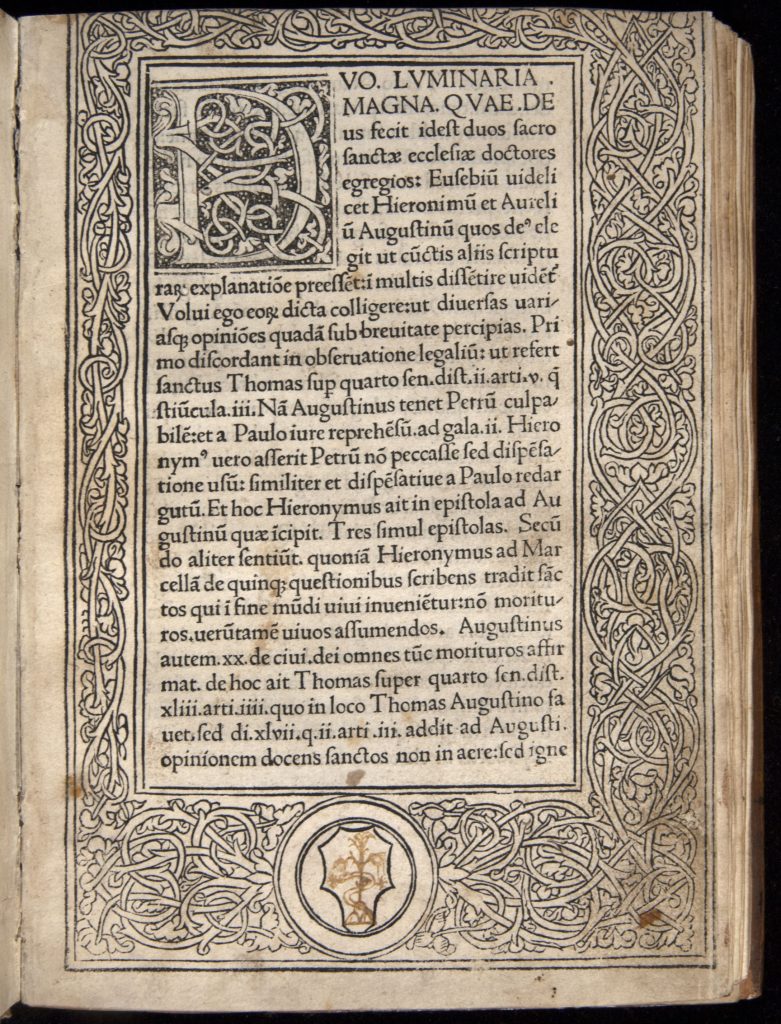
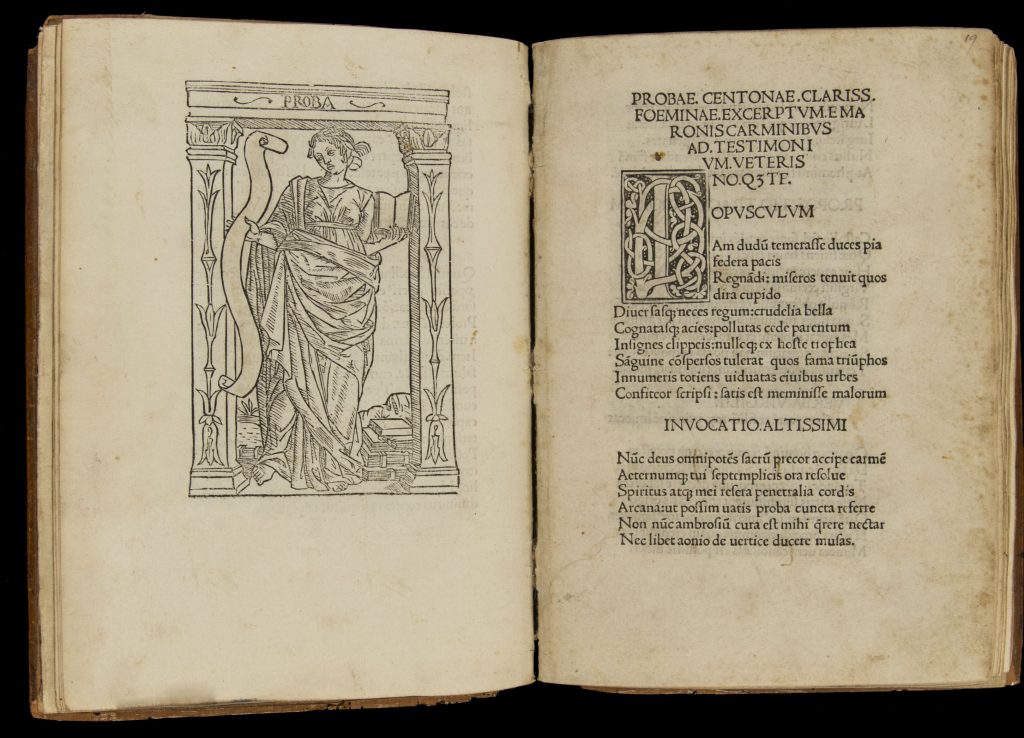

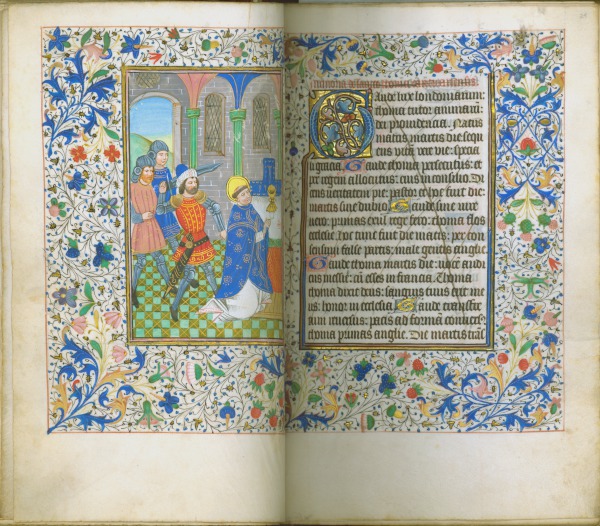
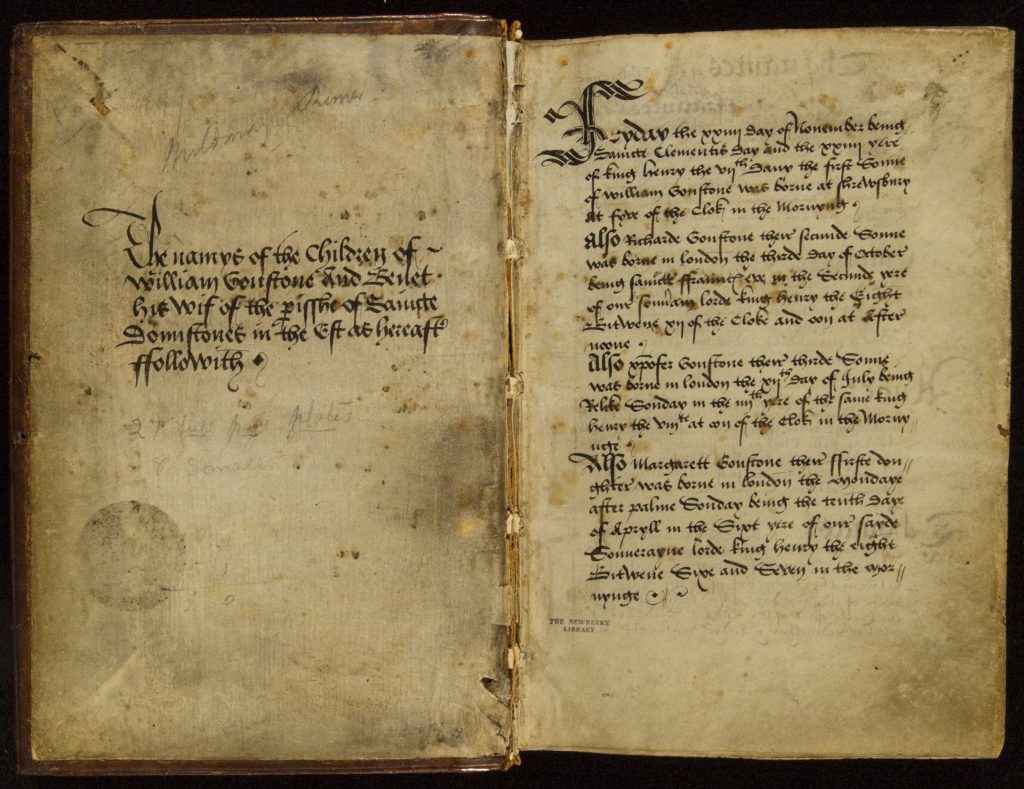
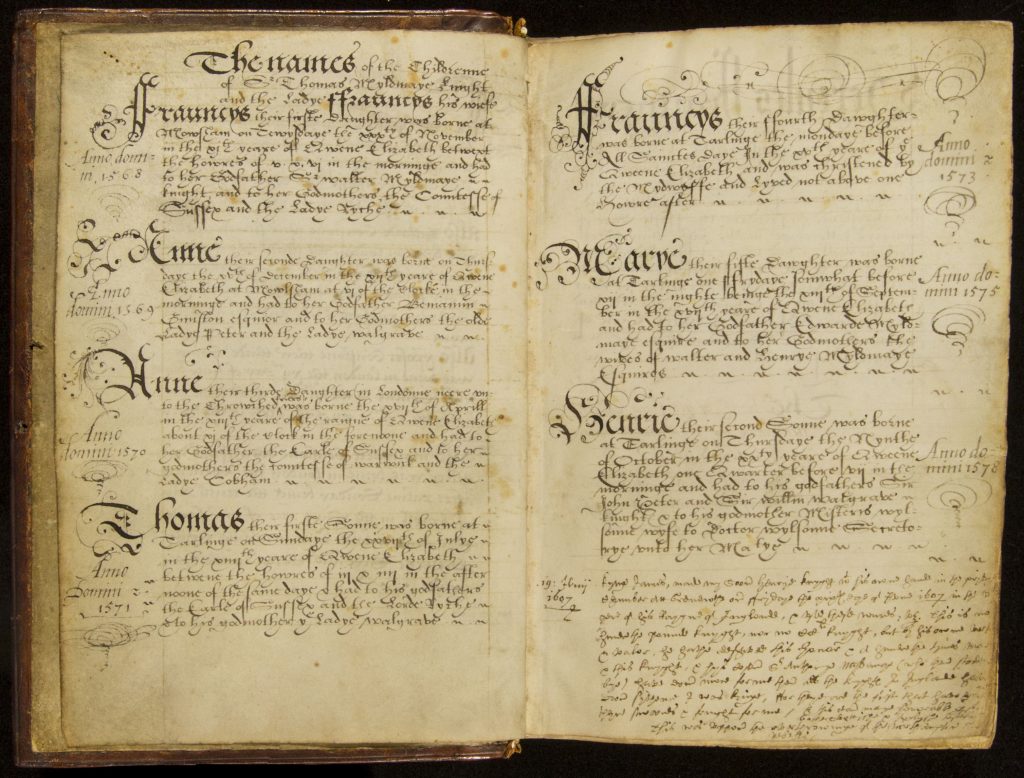





Further Reading
Bender, Thomas. The University and the City: From Medieval Origins to the Present. London: Oxford University Press, 1991.
Clemens, Raymond, and Timothy Graham. Introduction to Manuscript Studies. New York: Cornell University Press, 2007.
Frugoni, Chiara. Books, Banks, Buttons: And Other Inventions from the Middle Ages. Translated by William MCCuaig. New York: Columbia University Press, 2005.
Haskins, Charles Homer. The Renaissance of the Twelfth Century. Cambridge: Harvard University Press, 1927, revised 1955.
Madigan, Kevin. Medieval Christianity: A New History. New Haven: Yale University Press, 2015.
Southern, Richard. Scholastic Humanism and the Unification of Europe, Volume I: Foundations; Volume 2: The Heroic Age. Hoboken, NJ: Wiley-Blackwell, 1997, 2001.
Starkey, David. Magna Carta: The Medieval Roots of Modern Politics. London: Quercus, 2015.



